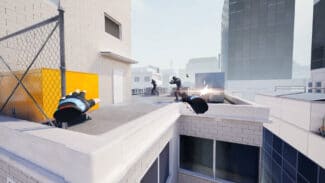Stride has the foundation for a fantastic VR parkour game, it just needs to apply itself properly. Find out more in our Stride review.
Note: This review is based on the Quest edition of the game. Stride is still in Early Access on Steam and the Quest version is essentially the same experience. However, as Facebook doesn’t label games as Early Access on the Quest store, we’re giving it a full review that we’ll update as new features arrive for the title.
You’ve probably heard by now that Stride is something like Mirror’s Edge in VR. That, it turns out, is putting it mildly.
Not only is JoyWay’s fast and fluid gameplay reminiscent of EA’s often overlooked franchise, but the game’s style and tone are practically carbon copies of it too. There’s the pure white cityscape, which is ripped straight from Faith’s adventures, and even the nimble combat tries to keep pace with its inspiration. Were it not for the fact that A. it’s in VR and B. EA seems allergic to actually making Mirror’s Edge games, you could easily mistake it for one.
Stride suffers from an identity crisis, then, reflected in the game’s aimless direction at launch. It’s all limbered up with nowhere to run, with three undeniably fun modes that should be appearing in addition to something bigger, not the meat of the experience.
Fortunately, Stride nails its core mechanics, making even the current build something that can get its hooks in you. To walk, you use the analog stick, but running requires moving your arms back and forth and jumping means holding the A button and swinging your arms up to propel yourself into the air. As I said when I previewed the game a year ago now, this takes some getting used to. The difference between then and now, though, is that I’ve actually had the time to get used to it. It’s still a little on the tricky side, tying your brain in knots as you try to process where your arms need to be and when to lift your thumb off of the button but once you’ve got it down, it works wonders. Throwing yourself over the map is weighty and physical, and really conveys a unique athleticism.
Other moves are easier to grasp: wall running requires jumping at a surface at the right angle, sliding needs to you quickly duck, and you can grab ledges to propel yourself over the top, zip down lines and even swing across chasms with a hookshot. It’s a versatile moveset that controls better than you might think, keeping you on your toes for long stretches of gameplay with varied acrobatics. The more you play, the more you’ll spot opportunities to switch up moves in the map, with diverging paths offering faster ways to clear gaps and avoid enemies.
It is possible to get yourself caught in the environment from time to time, and the game could do with another pass on the wider polish front (the tutorial’s auto-generated narration highlights typos in the script, for example). But, considering just how messy you might expect this brand of VR to be, Stride is actually a remarkably cohesive experience.
The three modes on offer aim to change up how you approach the game, too. Endless Mode is still Stride at its purest, getting you to charge down paths, ducking to avoid enemy gunfire and — new to this build — avoiding traps set by drones you can shoot down. It’s brilliantly impulsive and fleet-footed, forcing you to make up plans as you speed head-first towards them. Arena, meanwhile, is an objective-based survival mode that sees you switch between hitting checkpoints, collecting items and taking out enemies in a small section of city skyline. Finally, Time Mode has you clearing set courses as quickly as possible.
Hold these modes up together and you can catch a glimpse of the game Stride should be. Arena’s my personal favorite, asking you to negotiate cluttered, confined spaces and make constant, breathless leaps across buildings. It demonstrates the potential for its agile brand of combat, including melee attacks and shootouts with a pistol, too. It’s as much an endurance test as it is anything else, and you’ll find yourself savoring the precious few moments to catch your breath between objectives. Think of it as VR’s answer to the beep test.
Time Attack should be where the game really shines, but it’s quite easy as it stands and I was able to clear the final, hardest level with the highest score in just two attempts. And that’s ultimately true of the other offerings too; it’s not too long before Endless Modes’ regurgitation of a handful of paths becomes familiar, and cycling through the three main objectives means you’ll have seen all Arena has to offer in just a few goes. The game never really applies you and digs into the complexity of its mechanics for a truly challenging experience. And, aside from the hunt for high scores and a small system that unlocks power-ups within the given game type, there’s little in the way of progression.
Again, taken on their own these modes are fun and a great workout, but Stride needs to bash them into shape, throw them and other concepts into a cauldron and see if it can concoct something much more meaningful. Story and Multiplayer modes are on the way (the PC version is currently testing the latter) and have the chance to really set the game apart. Without them, this version of Stride is a bit of a false start.
Stride Review – Final Impressions
As it stands, Stride has a great foundation that doesn’t apply itself properly. A few tricky aspects aside, the game handles incredibly well, capturing the thrills, speed and exhaustion of parkour. But, while certainly addictive, the three modes on offer in the current Oculus Quest release don’t make the most of the mechanics, and feel like they’re in service to missing, larger modes. Those other options are on the way and we’ll take a look at Stride again once they’re here but, for now, Stride is a fun game with modes that can’t keep the pace going.

 For more on how we arrived at this rating, read our review guidelines. What did you make of our Arcsmith review? Let us know in the comments below!
For more on how we arrived at this rating, read our review guidelines. What did you make of our Arcsmith review? Let us know in the comments below!







